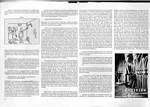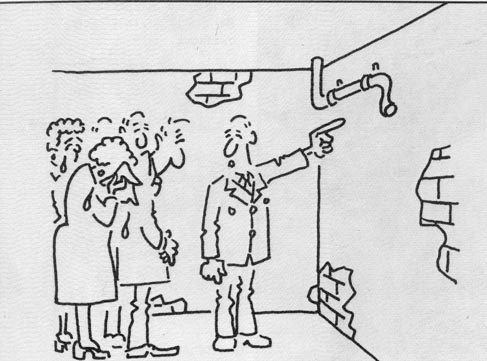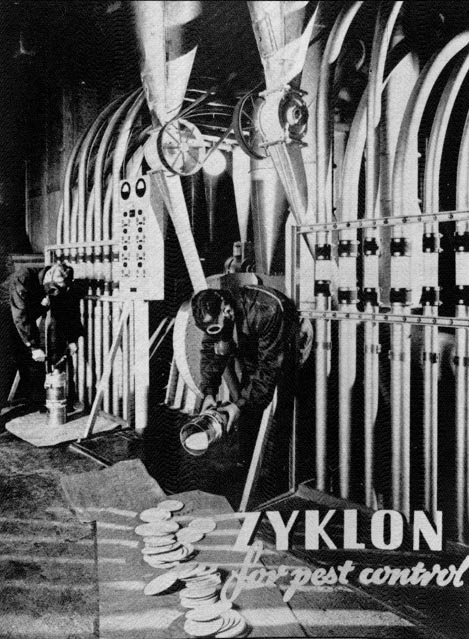|
|
 |
 |
AUSCHWITZ:
Technique
and Operation
of
the Gas Chambers © | |
|
| |
 |
Back |
 |
Contents |
Page 16 |
 |
Home
Page |
Forward |
 |
| |
| This lack of knowledge and confusion led to a complete gap in people's
minds summed up perfectly in Konk's drawing below. [Photo 4,
extract from page 60 of the album Aux voleurs, published by
Albin Michel in June 1986.] |
| |
 |
| Photo 4: |
| |
Before studying in detail the design and operation of the gas
chambers, delousing or homicidal, both based on the same principle,
it is essential to study the toxic products used in them. In
Auschwitz-Birkenau, only Zyklon-B was used. What is this product and
what are its characteristics?
The best document for the
historian concerning Zyklon B is NI-9912 (CDJC ref. CLIXa 21) [Document 5] (Page 18). It perfectly
summarizes the different characteristics of the product, its
toxicity, utilization, shelf life and how to protect people using
it. It describes the complete gassing operation (to destroy vermin)
and the concentration to be used us a function of the duration of
the application. It was Faurisson who was the first to publish it,
while traditional historians had ignored it. According to Faurisson
paragraph XI point 12 and paragraph XIV point 1 are vital, since
they indicate that the premises must be ventilated for at least 20
HOURS and, according to him, this document: |
| |
"demolishes all the so-called "testimonies" without
exception, on the use of Zyklon-B to kill human
beings" |
But Faurisson is not interested in the properties of HCN
(prussic or hydrocyanic acid), because these demolish two of his
"affirmations". In Krematorium I, he says that the gas chamber could
not have been next to the furnace room because there would be the
risk of the HCN exploding. The concentration used for homicidal
gassing is approximately 12g/m3 and, as the risk of explosion
appears at 75g/m3 (in fact as from 67.2g/m3), his argument
collapses for Krematorium I. It does not apply in the case of
Krematorien II and III, since the gas chambers were in the basement
and the furnaces on the ground floor, nor in IV and V, where the gas
chambers were separated from the furnaces by an airlock, the
morgue/undressing room and a vestibule.
Faurisson's
second affirmation was advanced as a desperate attempt to explain
the presence of cyanides, found as a result of toxicological
analysis of the upper ventilation grills of Leichenkeller I
(underground morgue, then gas chamber) of Krematorien II and III
indicating the use of HCN in these basement premises, He explains
that: |
| |
"a morgue is disinfected using
Zyklon-B" |
Here again, he is out of luck, for HCN has no effect on
bacteria. Disinfection is not carried out with a powerful
insecticide such as Zyklon-B, but with a bactericide such as bleach.
NI 9912 won an unexpected disciple over to Faurisson: the
political cartoonist Konk. Two pages (60 and 61) of his album
Au Voleurs deal with testimonies/war stories (60) and
the ventilation of gas chambers (61 [Photo 6]. Page 60 is excellent,
and I mean that. As for page 6l, Konk has allowed himself to be
trapped by the argument of maniacs who spend their lives trying to
demonstrate that something never existed. Konk, an absolute
neophyte, started to have doubts when watching a scene of gassing at
Treblinka in the film "Au nom de tous les miens" (Interview with
Konk by the newspaper "Liberation" of 8th August 1986). He forgot
that the Treblinka gas chambers used CO (carbon monoxide), contained
in the exhaust gas of a tank engine (gasoline or diesel, both being
equally deadly for humans). However, his drawing shows the
functioning of a Zyklon-B gas chamber. There is no connection
between the two. Konk should have informed himself directly at
Auschwitz, so that he could have avoided writing and drawing
nonsense. His SS man pouring the Zyklon-B is not wearing a mask.
This is impossible, for he would die as soon as he opened the can.
As for the ladder leaning against the roof, I do not know what
Faurisson thinks, but when, in my article on Krematorien IV and V, I
stated that an SS man climbed a small ladder to reach the
introduction windows in the gas chambers, Faurisson called me an
idiot for describing a practice which in his opinion could lead only
to "sniffings".
There remains the question of the 20
hours, which despite appearances, is very difficult to integrate in
the picture of a homicidal gas chamber. I shall argue on the basis
of Leichenkeller I (500 to 550 cubic meters) of Krematorien II and
III. The SS chose Zyklon-B for its high degree of toxicity on warm
blooded animals, including man. The meticulous care stipulated in NI
9912 has no sense in homicidal gassing, because this changes the
situation radically. The space where the gas was used was closed and
gas tight. No furniture, bedding or floor covering. The floor, walls
and ceilings were of bare concrete (except for about twenty dummy
wooden shower heads installed in the ceiling). Forced draught
ventilation would be relatively efficient in these circumstances.
After 15 minutes of ventilation the air in the room would be
completely renewed. A homicidal gassing (using 5 to 7kg of Zyklon-B
for 1,000 to 2,000 persons) would last about 20 minutes: 5 minutes
for the action of the HCN bringing swift death (the quantity
introduced being 40 times the lethal dose) and 15 minutes of
ventilation BEFORE BEING ABLE TO OPEN THE GAS TIGHT DOOR. Although a
part of the toxic gas had been inhaled by the victims, this was
negligible with respect to the quantity remaining, due to the
initial overdose.
Here, Faurisson is right when he states
that the operating sequences as described by the witnesses give rise
to an almost insurmountable difficulty. For example, Camp Commandant
Hoess and Dr. Nyiszli report EXACTLY the same sequence: pouring of
Zyklon-B through the openings In the ceiling, the pellets running
down the four wire-mesh columns and rapid diffusion of HCN by
evaporation in the room "preheated" by human body heat. In 5 or l0
minutes, everybody was dead. Then there was a FURTHER wait of 20 to
30 minutes BEFORE switching on the ventilation. The door was opened
and the extraction of bodies commenced immediately ("sofort"). This is
the process as SEEN AND HEARD by witnesses. But why wait 20 to 30
minutes after the complete death of the victims before opening the
door? This is waste of time when we consider the rapid throughput
rates imposed by the SS, always in a hurry. Hoess and Nyiszli are
mistaken as regards the moment at which the ventilation began. It
was in fact switched on not more than 10 minutes AFTER the
introduction of the gas and it was left running FOR 20 to 30 minutes
BEFORE the door was opened. The witnesses state the contrary, and
for them it is the truth. The fact is that as long as the gas tight
door remained closed, no SOUND could be heard and people could see
INTO the gas chamber only through the inspection peephole. The
switching on of the ventilation could not be heard because the motor
was located in the roof space of the Krematorium and the witnesses
were in the basement. What is more, there were five or six electric
motors in the root space, three of them being used for other
ventilation systems. How was it possible to distinguish the noise of
the gas chamber ventilation motor if that of the furnace room, of
the same power, was running at the same time? In truth, the
witnesses HEARD the noise of the ventilator fans WHEN the door was
opened and they had THE IMPRESSION that the ventilation had just
been switched on.
Contrary to Faurisson's allegations, Dr.
Nyiszli stresses the difficulty of eliminating the Zyklon-B
remaining, due to the initial overdose, noting that: |
| |
"in the crannies between the dead and the cracks of
the doors small pockets of it always remained. Even two hours
later it caused a suffocating cough (due to the warning agent] For
that reason the Sonderkommando group which first moved into the
room was equipped with gas masks" [ Auschwitz: A Doctor's
eyewitness account page 48] |
This type of unimportant detail did not concern Hoess, who was
too preoccupied with his position as camp commandant and the pangs
of conscience of the SS with respect to the extermination of Jewish
women and children.
In Krematorien IV and V, whose gas
chambers had only natural ventilation, I have found only one
(admittedly slight) indication in Le cahier d'Alfred
Kantor (Stock,1972),where the illustration on page 577 shows
the extraction of corpses from a ground floor gas chamber, hence
Krematorium IV or V, by prisoners wearing gas masks. In this case,
without a mask it is obvious that the immediate handling of bodies
after gassing would end like Konk's last drawing, death for all. It
must be noted that witnesses very often do not mention details that
appear so evident to them that they forget them (for example, the
guillotine type opening system of the doors of the 8 muffle furnaces
of Krematorien IV and V was not described by any former member of
the Sonderkommando)
Zyklon-B was produced by DEGESCH
(Deutsche Gesellschaft für Schadlingsbekämpfung/German pest control
company), located at 32-40 Weismüllerstrasse, Frankfurt am Main.
Founded in 1917, by the technical committee for pest control of the
War Ministry of the German Government of the time, this, admittedly
pacific, creation, was not exempt from certain ulterior motives
with regard to chemical warfare (the use of HCN as a chemical weapon
is always topical because of its immediate and devastating action,
making it suitable for use in the front line in order to "clear" the
terrain before an attacking army). The trade name of "Zyklon" has
been replaced by that of "Cyanosil" through changing the porous
support receiving the HCN. Photos 7, 8, 9 and
10 come from a brochure issued by Degesch in 1972.
Photo 7 shows insecticide gassing in a modern flour mill and
Photo 8 an older one, using Zyklon in disk form (in the book
by Joechen von Lang, Eichmann l'interrogatoire, Belfond
1984, Eichmann says of Zyklon-B: "it came in the form of cardboard
disks, like beer mats"). The operators are wearing gas masks fitted
with "J" type filter cartridges (Photo 11). Photo 9
shows the three sizes of cans available, 500g, 1kg and 1.5kg (from
left to right) and the alternative forms of pellets and disks. The
case in which these cans are delivered is standard, 0.72 by 0.50 by
0.36m and contains either 12 cans of 1500g, 16 of 100g, or 30 of
500g. Photo 12 shows the label from one of these cases in
1944. Photo 10 shows the device now used to open the cans (In
Auschwitz the SS used a metal tool with one end broadened and having
teeth round the edge: the teeth fitted into the cover of the can
which came off with a sharp blow with a hammer. A faithful
demonstration of this technique can be seen in a gassing scene in
Andrzej Munk's film La Passagère but there the SS wear
thick rubber gloves to handle the Zyklon-B, while the Degesch
operators do without them). The director of Degesch
| |
| |
 |
| Photo 7 |
AUSCHWITZ:
Technique
and operation
of the gas chambers
Jean-Claude Pressac
© 1989, The
Beate Klarsfeld Foundation |
 |
Back |
Page 16 |
Forward |
 |
|

